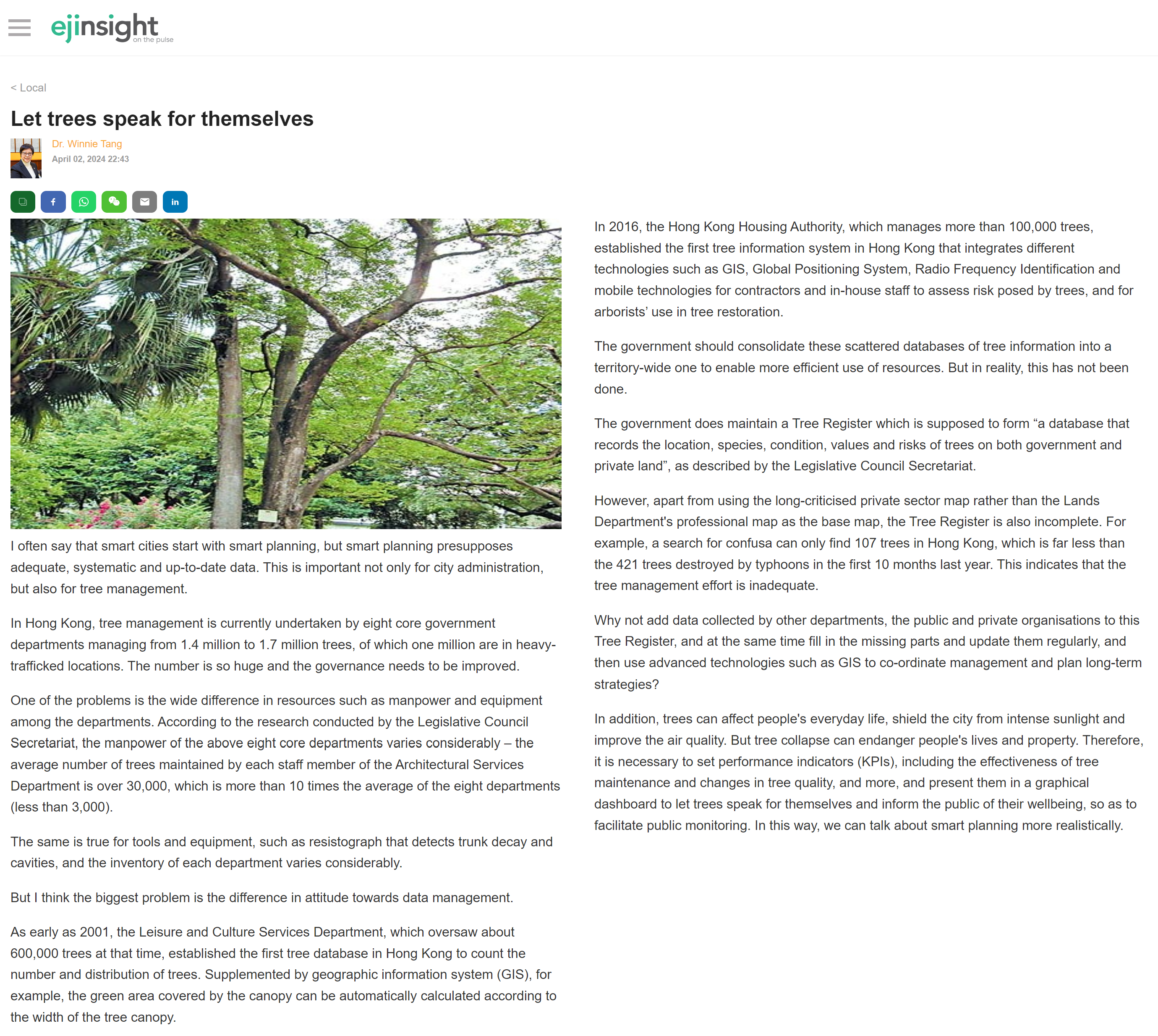網上版請按此

Let trees speak for themselves
I often say that smart cities start with smart planning, but smart planning presupposes adequate, systematic and up-to-date data. This is important not only for city administration, but also for tree management.
In Hong Kong, tree management is currently undertaken by eight core government departments managing from 1.4 million to 1.7 million trees, of which one million are in heavy-trafficked locations. The number is so huge and the governance needs to be improved.
One of the problems is the wide difference in resources such as manpower and equipment among the departments. According to the research conducted by the Legislative Council Secretariat, the manpower of the above eight core departments varies considerably – the average number of trees maintained by each staff member of the Architectural Services Department is over 30,000, which is more than 10 times the average of the eight departments (less than 3,000).
The same is true for tools and equipment, such as resistograph that detects trunk decay and cavities, and the inventory of each department varies considerably.
But I think the biggest problem is the difference in attitude towards data management.
As early as 2001, the Leisure and Culture Services Department, which oversaw about 600,000 trees at that time, established the first tree database in Hong Kong to count the number and distribution of trees. Supplemented by geographic information system (GIS), for example, the green area covered by the canopy can be automatically calculated according to the width of the tree canopy.
In 2016, the Hong Kong Housing Authority, which manages more than 100,000 trees, established the first tree information system in Hong Kong that integrates different technologies such as GIS, Global Positioning System, Radio Frequency Identification and mobile technologies for contractors and in-house staff to assess risk posed by trees, and for arborists’ use in tree restoration.
The government should consolidate these scattered databases of tree information into a territory-wide one to enable more efficient use of resources. But in reality, this has not been done.
The government does maintain a Tree Register which is supposed to form “a database that records the location, species, condition, values and risks of trees on both government and private land”, as described by the Legislative Council Secretariat.
However, apart from using the long-criticised private sector map rather than the Lands Department's professional map as the base map, the Tree Register is also incomplete. For example, a search for confusa can only find 107 trees in Hong Kong, which is far less than the 421 trees destroyed by typhoons in the first 10 months last year. This indicates that the tree management effort is inadequate.
Why not add data collected by other departments, the public and private organisations to this Tree Register, and at the same time fill in the missing parts and update them regularly, and then use advanced technologies such as GIS to co-ordinate management and plan long-term strategies?
In addition, trees can affect people's everyday life, shield the city from intense sunlight and improve the air quality. But tree collapse can endanger people's lives and property. Therefore, it is necessary to set performance indicators (KPIs), including the effectiveness of tree maintenance and changes in tree quality, and more, and present them in a graphical dashboard to let trees speak for themselves and inform the public of their wellbeing, so as to facilitate public monitoring. In this way, we can talk about smart planning more realistically.
Dr. Winnie Tang
Adjunct Professor, Department of Computer Science, Faculty of Engineering; Department of Geography, Faculty of Social Sciences; and Faculty of Architecture, The University of Hong Kong